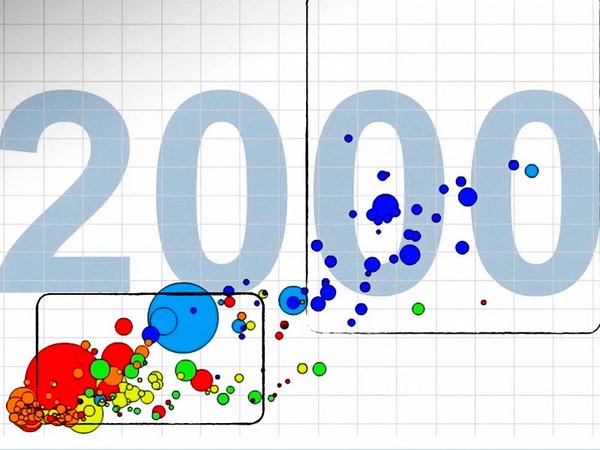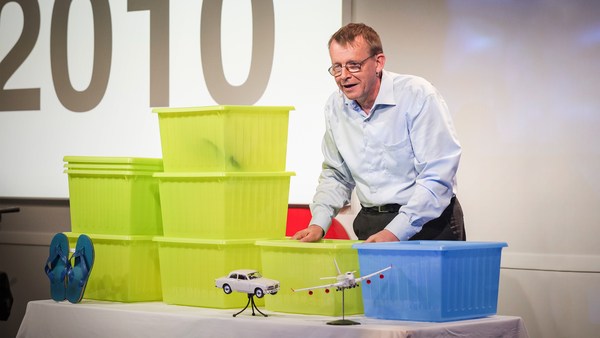I told you three things last year. I told you that the statistics of the world have not been made properly available. Because of that, we still have the old mindset of developing in industrialized countries, which is wrong. And that animated graphics can make a difference. Things are changing and today, on the United Nations Statistic Division Home Page, it says, by first of May, full access to the databases. (Applause) And if I could share the image with you on the screen. So three things have happened. U.N. opened their statistic databases, and we have a new version of the software up working as a beta on the net, so you don't have to download it any longer.
And let me repeat what you saw last year. The bubbles are the countries. Here you have the fertility rate -- the number of children per woman -- and there you have the length of life in years. This is 1950 -- those were the industrialized countries, those were developing countries. At that time there was a "we" and "them." There was a huge difference in the world. But then it changed, and it went on quite well.
And this is what happens. You can see how China is the red, big bubble. The blue there is India. And they go over all this -- I'm going to try to be a little more serious this year in showing you how things really changed. And it's Africa that stands out as the problem down here, doesn't it? Large families still, and the HIV epidemic brought down the countries like this. This is more or less what we saw last year, and this is how it will go on into the future.
And I will talk on, is this possible? Because you see now, I presented statistics that don't exist. Because this is where we are. Will it be possible that this will happen? I cover my lifetime here, you know? I expect to live 100 years. And this is where we are today. Now could we look here instead at the economic situation in the world? And I would like to show that against child survival. We'll swap the axis. Here you have child mortality -- that is, survival -- four kids dying there, 200 dying there. And this is GDP per capita on this axis. And this was 2007.
And if I go back in time, I've added some historical statistics -- here we go, here we go, here we go -- not so much statistics 100 years ago. Some countries still had statistics. We are looking down in the archive, and when we are down into 1820, there is only Austria and Sweden that can produce numbers. (Laughter) But they were down here. They had 1,000 dollars per person per year. And they lost one-fifth of their kids before their first birthday.
So this is what happens in the world, if we play the entire world. How they got slowly richer and richer, and they add statistics. Isn't it beautiful when they get statistics? You see the importance of that? And here, children don't live longer. The last century, 1870, was bad for the kids in Europe, because most of this statistics is Europe. It was only by the turn of the century that more than 90 percent of the children survived their first year. This is India coming up, with the first data from India. And this is the United States moving away here, earning more money. And we will soon see China coming up in the very far end corner here. And it moves up with Mao Tse-Tung getting health, not getting so rich. There he died, then Deng Xiaoping brings money. It moves this way over here. And the bubbles keep moving up there, and this is what the world looks like today. (Applause)
Let us have a look at the United States. We have a function here -- I can tell the world, "Stay where you are." And I take the United States -- we still want to see the background -- I put them up like this, and now we go backwards. And we can see that the United States goes to the right of the mainstream. They are on the money side all the time. And down in 1915, the United States was a neighbor of India -- present, contemporary India. And that means United States was richer, but lost more kids than India is doing today, proportionally. And look here -- compare to the Philippines of today. The Philippines of today has almost the same economy as the United States during the First World War. But we have to bring United States forward quite a while to find the same health of the United States as we have in the Philippines. About 1957 here, the health of the United States is the same as the Philippines. And this is the drama of this world which many call globalized, is that Asia, Arabic countries, Latin America, are much more ahead in being healthy, educated, having human resources than they are economically.
There's a discrepancy in what's happening today in the emerging economies. There now, social benefits, social progress, are going ahead of economical progress. And 1957 -- the United States had the same economy as Chile has today. And how long do we have to bring United States to get the same health as Chile has today? I think we have to go, there -- we have 2001, or 2002 -- the United States has the same health as Chile. Chile's catching up! Within some years Chile may have better child survival than the United States. This is really a change, that you have this lag of more or less 30, 40 years' difference on the health.
And behind the health is the educational level. And there's a lot of infrastructure things, and general human resources are there. Now we can take away this -- and I would like to show you the rate of speed, the rate of change, how fast they have gone. And we go back to 1920, and I want to look at Japan. And I want to look at Sweden and the United States. And I'm going to stage a race here between this sort of yellowish Ford here and the red Toyota down there, and the brownish Volvo. (Laughter) And here we go. Here we go. The Toyota has a very bad start down here, you can see, and the United States Ford is going off-road there. And the Volvo is doing quite fine. This is the war. The Toyota got off track, and now the Toyota is coming on the healthier side of Sweden -- can you see that? And they are taking over Sweden, and they are now healthier than Sweden. That's the part where I sold the Volvo and bought the Toyota. (Laughter) And now we can see that the rate of change was enormous in Japan. They really caught up.
And this changes gradually. We have to look over generations to understand it. And let me show you my own sort of family history -- we made these graphs here. And this is the same thing, money down there, and health, you know? And this is my family. This is Sweden, 1830, when my great-great-grandma was born. Sweden was like Sierra Leone today. And this is when great-grandma was born, 1863. And Sweden was like Mozambique. And this is when my grandma was born, 1891. She took care of me as a child, so I'm not talking about statistic now -- now it's oral history in my family. That's when I believe statistics, when it's grandma-verified statistics. (Laughter) I think it's the best way of verifying historical statistics. Sweden was like Ghana. It's interesting to see the enormous diversity within sub-Saharan Africa. I told you last year, I'll tell you again, my mother was born in Egypt, and I -- who am I? I'm the Mexican in the family. And my daughter, she was born in Chile, and the grand-daughter was born in Singapore, now the healthiest country on this Earth. It bypassed Sweden about two to three years ago, with better child survival. But they're very small, you know? They're so close to the hospital we can never beat them out in these forests. (Laughter) But homage to Singapore.
Singapore is the best one. Now this looks also like a very good story. But it's not really that easy, that it's all a good story. Because I have to show you one of the other facilities. We can also make the color here represent the variable -- and what am I choosing here? Carbon-dioxide emission, metric ton per capita. This is 1962, and United States was emitting 16 tons per person. And China was emitting 0.6, and India was emitting 0.32 tons per capita. And what happens when we moved on? Well, you see the nice story of getting richer and getting healthier -- everyone did it at the cost of emission of carbon dioxide. There is no one who has done it so far. And we don't have all the updated data any longer, because this is really hot data today. And there we are, 2001.
And in the discussion I attended with global leaders, you know, many say now the problem is that the emerging economies, they are getting out too much carbon dioxide. The Minister of the Environment of India said, "Well, you were the one who caused the problem." The OECD countries -- the high-income countries -- they were the ones who caused the climate change. "But we forgive you, because you didn't know it. But from now on, we count per capita. From now on we count per capita. And everyone is responsible for the per capita emission."
This really shows you, we have not seen good economic and health progress anywhere in the world without destroying the climate. And this is really what has to be changed. I've been criticized for showing you a too positive image of the world, but I don't think it's like this. The world is quite a messy place. This we can call Dollar Street. Everyone lives on this street here. What they earn here -- what number they live on -- is how much they earn per day. This family earns about one dollar per day. We drive up the street here, we find a family here which earns about two to three dollars a day. And we drive away here -- we find the first garden in the street, and they earn 10 to 50 dollars a day.
And how do they live? If we look at the bed here, we can see that they sleep on a rug on the floor. This is what poverty line is -- 80 percent of the family income is just to cover the energy needs, the food for the day. This is two to five dollars. You have a bed. And here it's a much nicer bedroom, you can see. I lectured on this for Ikea, and they wanted to see the sofa immediately here. (Laughter) And this is the sofa, how it will emerge from there. And the interesting thing, when you go around here in the photo panorama, you see the family still sitting on the floor there. Although there is a sofa, if you watch in the kitchen, you can see that the great difference for women does not come between one to 10 dollars. It comes beyond here, when you really can get good working conditions in the family. And if you really want to see the difference, you look at the toilet over here. This can change. This can change. These are all pictures and images from Africa, and it can become much better. We can get out of poverty.
My own research has not been in IT or anything like this. I spent 20 years in interviews with African farmers who were on the verge of famine. And this is the result of the farmers-needs research. The nice thing here is that you can't see who are the researchers in this picture. That's when research functions in poor societies -- you must really live with the people.
When you're in poverty, everything is about survival. It's about having food. And these two young farmers, they are girls now -- because the parents are dead from HIV and AIDS -- they discuss with a trained agronomist. This is one of the best agronomists in Malawi, Junatambe Kumbira, and he's discussing what sort of cassava they will plant -- the best converter of sunshine to food that man has found. And they are very, very eagerly interested to get advice, and that's to survive in poverty. That's one context. Getting out of poverty. The women told us one thing. "Get us technology. We hate this mortar, to stand hours and hours. Get us a mill so that we can mill our flour, then we will be able to pay for the rest ourselves." Technology will bring you out of poverty, but there's a need for a market to get away from poverty. And this woman is very happy now, bringing her products to the market. But she's very thankful for the public investment in schooling so she can count, and won't be cheated when she reaches the market. She wants her kid to be healthy, so she can go to the market and doesn't have to stay home. And she wants the infrastructure -- it is nice with a paved road. It's also good with credit. Micro-credits gave her the bicycle, you know. And information will tell her when to go to market with which product. You can do this.
I find my experience from 20 years of Africa is that the seemingly impossible is possible. Africa has not done bad. In 50 years they've gone from a pre-Medieval situation to a very decent 100-year-ago Europe, with a functioning nation and state. I would say that sub-Saharan Africa has done best in the world during the last 50 years. Because we don't consider where they came from. It's this stupid concept of developing countries that puts us, Argentina and Mozambique together 50 years ago, and says that Mozambique did worse. We have to know a little more about the world. I have a neighbor who knows 200 types of wine. He knows everything. He knows the name of the grape, the temperature and everything. I only know two types of wine -- red and white. (Laughter) But my neighbor only knows two types of countries -- industrialized and developing. And I know 200, I know about the small data. But you can do that. (Applause)
But I have to get serious. And how do you get serious? You make a PowerPoint, you know? (Laughter) Homage to the Office package, no? What is this, what is this, what am I telling? I'm telling you that there are many dimensions of development. Everyone wants your pet thing. If you are in the corporate sector, you love micro-credit. If you are fighting in a non-governmental organization, you love equity between gender. Or if you are a teacher, you'll love UNESCO, and so on. On the global level, we have to have more than our own thing. We need everything. All these things are important for development, especially when you just get out of poverty and you should go towards welfare.
Now, what we need to think about is, what is a goal for development, and what are the means for development? Let me first grade what are the most important means. Economic growth to me, as a public-health professor, is the most important thing for development because it explains 80 percent of survival. Governance. To have a government which functions -- that's what brought California out of the misery of 1850. It was the government that made law function finally. Education, human resources are important. Health is also important, but not that much as a mean. Environment is important. Human rights is also important, but it just gets one cross.
Now what about goals? Where are we going toward? We are not interested in money. Money is not a goal. It's the best mean, but I give it zero as a goal. Governance, well it's fun to vote in a little thing, but it's not a goal. And going to school, that's not a goal, it's a mean. Health I give two points. I mean it's nice to be healthy -- at my age especially -- you can stand here, you're healthy. And that's good, it gets two plusses. Environment is very, very crucial. There's nothing for the grandkid if you don't save up. But where are the important goals? Of course, it's human rights. Human rights is the goal, but it's not that strong of a mean for achieving development. And culture. Culture is the most important thing, I would say, because that's what brings joy to life. That's the value of living.
So the seemingly impossible is possible. Even African countries can achieve this. And I've shown you the shot where the seemingly impossible is possible. And remember, please remember my main message, which is this: the seemingly impossible is possible. We can have a good world. I showed you the shots, I proved it in the PowerPoint, and I think I will convince you also by culture. (Laughter) (Applause) Bring me my sword! Sword swallowing is from ancient India. It's a cultural expression that for thousands of years has inspired human beings to think beyond the obvious. (Laughter) And I will now prove to you that the seemingly impossible is possible by taking this piece of steel -- solid steel -- this is the army bayonet from the Swedish Army, 1850, in the last year we had war. And it's all solid steel -- you can hear here. And I'm going to take this blade of steel, and push it down through my body of blood and flesh, and prove to you that the seemingly impossible is possible. Can I request a moment of absolute silence? (Applause)





